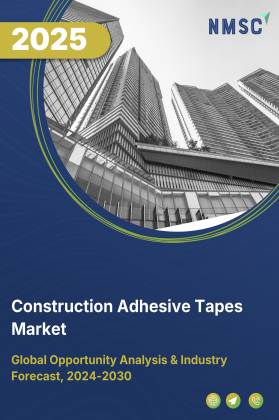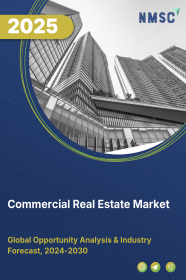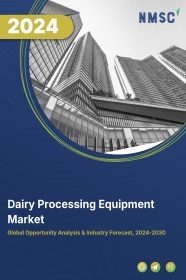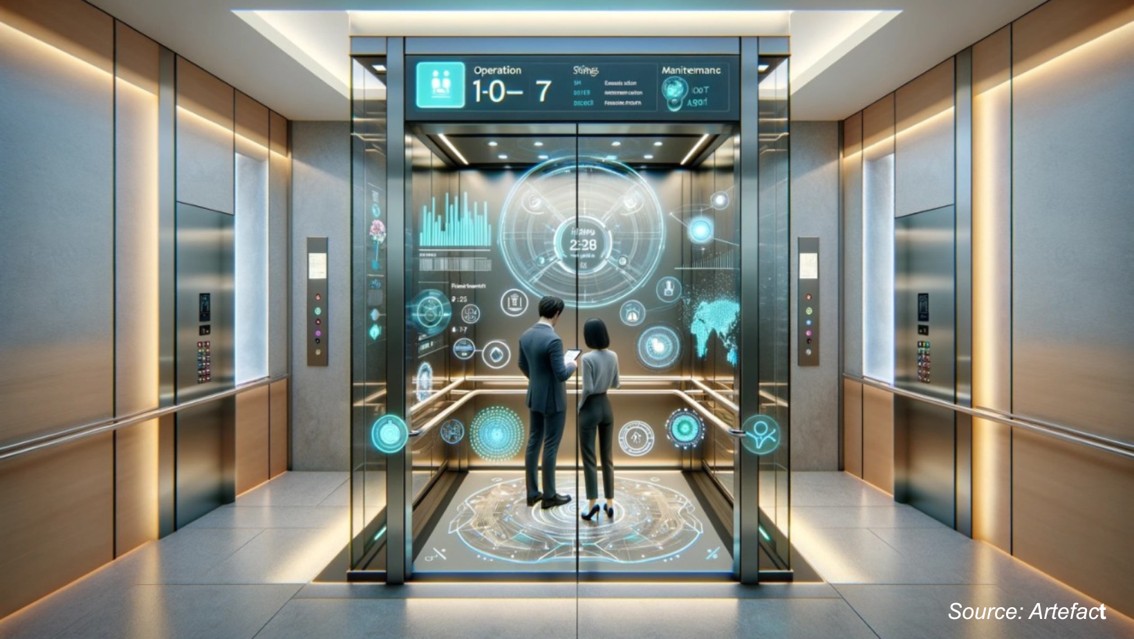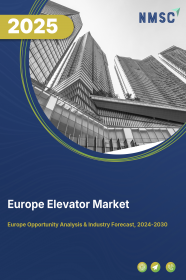
Europe Elevator Market by Type (Passenger elevator, Freight elevator, and Others), by Technology (Traction, and Hydraulic), by Service (New Installation, Maintenance, and Modernization), by Capacity (Less than 1500 kg, 1500 to 2500 kg, 2501 to 4000 kg, and More than 4000 kg) by Speed (Less than 1 M/S, Between 1 to 4 M/S, and More than 5 M/S), by Deck type (Single Deck and Others), by Designation Control (Smart, and Conventional) and Others- Opportunity Analysis and Industry Forecast, 2025 –2030
Industry: Construction & Manufacturing | Publish Date: 08-Aug-2025 | No of Pages: 412 | No. of Tables: 404 | No. of Figures: 349 | Format: PDF | Report Code : CM1611
Market Definition
According to NMSC, the Europe Elevator Market size in 2024 was USD 25.81 billion, and is estimated to reach USD 28.21 billion in 2025 and is projected to reach USD 35.81 billion by 2030 with a CAGR of 4.89%. According to NMSC, in term of volume the market size was 95 thousand units in 2024, and is estimated to reach 110 thousand units in 2025 and is projected to reach 157 thousand units by 2030 with a CAGR of 7.23%. The elevator market represents a dynamic sector encompassing the design, manufacturing, installation, and maintenance of elevator systems. From conventional traction elevators to cutting-edge smart solutions, this market offers a diverse array of vertical transportation choices customized to suit the distinct requirements of various buildings and infrastructure projects. Stakeholders within the elevator market include manufacturers, suppliers, contractors, architects, building owners, and facility managers.
Manufacturers continuously innovate to enhance elevator performance, safety, and sustainability, while suppliers provide critical components and materials necessary for system construction. Additionally, sustainability considerations, including energy efficiency and material recyclability, are increasingly integral to elevator design and operation. They align with broader environmental objectives and sustainable building practices. Thus, the elevator market is a cornerstone of vertical mobility as elevators enhance functionality, accessibility, and sustainability within buildings and urban landscapes worldwide.
Strategic Modernization Demand Fueled by Aging Infrastructure
Europe’s elevator market is witnessing strong growth in modernization projects due to its extensive base of aging elevator systems, particularly in countries like Germany, Italy, Spain, and France. Many of these systems were installed decades ago and now fall short of current safety, accessibility, and energy efficiency standards. Building owners are increasingly investing in system upgrades that incorporate advanced drive technologies, automated diagnostics, and modern cabin designs. Supportive regulatory frameworks—such as EU energy directives and local building codes—are accelerating this transition. The modernization trend not only improves performance and reliability but also aligns with Europe’s broader decarbonization and accessibility goals.
Digital Integration and ESG Goals Transform Market Expectations
The convergence of digital transformation and sustainability mandates is reshaping buyer priorities across the European elevator market. Stakeholders are increasingly opting for elevator solutions that contribute to ESG compliance—such as those with regenerative drives, eco-mode functions, and recyclable materials. At the same time, digital integration with IoT platforms and building management systems has moved from a premium feature to a core requirement. Real-time fault detection, usage analytics, remote access, and AI-driven service planning are now key differentiators. This shift is particularly pronounced in new developments and large-scale renovations, where investors and developers seek future-ready, low-maintenance, and low-impact mobility solutions.
Supply Chain Fragmentation And Component Shortages Hamper Delivery Schedules
The Europe elevator market is currently grappling with persistent supply chain fragmentation, particularly in the procurement of critical components such as semiconductors, drive Thousand Units, and IoT-enabled control systems. This challenge has been intensified by geopolitical tensions, raw material inflation, and over-reliance on non-European suppliers. Manufacturers and installers are experiencing prolonged lead times, affecting project delivery schedules for both new installations and modernization efforts.
Additionally, the push for localized sourcing—driven by EU strategic autonomy policies—has led to a transitional phase where supply networks are being restructured, but remain uneven across regions. Smaller service providers, in particular, face difficulty accessing advanced parts at competitive prices, creating disparities in service quality and timelines. The combined effect of these disruptions is a slowdown in project execution and rising operational costs, especially in time-sensitive urban infrastructure projects.
Urban Redevelopment And Retrofitting Initiatives Spur Elevator Demand In Existing Buildings
Europe’s strong policy push toward sustainable urban regeneration is creating a substantial opportunity for the elevator industry. With a significant portion of the building stock in Europe constructed before modern vertical mobility standards were established, national governments and the EU are increasingly investing in large-scale retrofitting programs to upgrade aging infrastructure. These initiatives aim to enhance energy efficiency, safety, and accessibility—especially in older residential complexes and public sector buildings that currently lack elevators.
As part of broader urban renewal and climate adaptation goals, retrofitting non-elevator buildings to include compact, energy-efficient lift systems is gaining traction across countries like Italy, Germany, France, and Spain. These projects are often supported by public subsidies and EU recovery funds, making them financially viable for homeowners, municipalities, and housing associations. For elevator manufacturers and solution providers, this presents a long-term growth avenue to introduce space-saving, modular, and sustainable elevator systems designed specifically for retrofitting constrained shafts and heritage structures.
Germany Holds the Dominant Market Share in Europe elevator Market
In Germany, where urban dwellers constituted 77.8% of the population in 2023, there exists a notable requirement for vertical mobility solutions, notably elevators. As urbanization continues to influence the environment, the necessity for efficient transportation within high-rise buildings, commercial complexes, and residential towers becomes progressively essential.
The clustering of people in urban settings highlights the significance of elevators in enabling convenient and accessible vertical transportation. Given the substantial urban population, there persists a consistent demand for elevators to address the vertical mobility requirements of residents, employees, and visitors alike.
Norway to Witness Substantial Growth in the Europe elevator Market
In Norway, where urbanization and infrastructure development are accelerating, there is a growing demand for the maintenance and modernization of elevators and escalators. Mitsubishi Electric's expansion efforts in Norway align closely with this increasing demand, signalling its intention to capture a significant share of the Norwegian elevator market. By prioritizing the building systems business, Mitsubishi Electric aims to meet the evolving needs of Norway's urban landscape, establishing itself as a prominent player in the country's elevator market. This strategic initiative underscores the company's dedication to delivering innovative solutions and addressing the rising demand for vertical mobility solutions in Norway and throughout Europe.
Competitive Landscape
The Europe elevator market comprises various market players, such as Canny Elevator Co., Ltd., SJEC Corporation (Suzhou Jiangnan Jiajie Elevator), Shenyang Yuanda Intellectual Industry Group Co., Ltd. (BLT Elevator), General Elevator Co., Ltd., IFE Elevators Co., Ltd., Ningbo Hosting Elevator Co., Ltd., Delfar Elevator Co., Ltd., Dongnan Elevator Co., Ltd., Joylive Elevator Co., Ltd., Suzhou Dazen Electromechanical Technology Co., Ltd., Shanghai Fuji Elevator Co., Ltd., Ningbo Conai Escalator & Elevator Co., Ltd., Yida Express Elevator CO., LTD, Fareo Elevator (Guangdong) Co., Ltd, and Kunshan Mini Mustang Tech. Co., Ltd.
Europe Elevator Market Key Segments
By Type
-
Passenger elevator
-
Freight elevator
-
Others
By Technology
-
Traction
-
Machine Room [MR] Traction
-
Machine Roomless [MRL] Traction
-
-
Hydraulic
By Service
-
New Installation
-
Maintenance
-
Modernization
By Capacity
-
Less than 1500 kg
-
1500 to 2500 kg
-
2501 to 4000 kg
-
More than 4000 kg
By Speed
-
Less than 1 M/S
-
Between 1 to 4 M/S
-
More than 5 M/S
By Deck Type
-
Single Deck
-
Double Deck
By Designation Control
-
Smart
-
Conventional
By Door Type
-
Automatic
-
Manual
By Application
-
Residential
-
Low Rise: 10 Floors
-
Mid Rise: 11-30 Floors
-
High Rise: Above 30 Floors
-
Villa/home
-
-
Commercial
-
Airport
-
Hotel
-
Marine
-
Medical
-
Retail
-
Leisure and Education
-
Public Transportation
-
-
Industrial
By Country
-
UK
-
Germany
-
France
-
Italy
-
Spain
-
Denmark
-
Netherlands
-
Finland
-
Sweden
-
Norway
-
Russia
-
Rest of Europe
Key Players
-
Canny Elevator Co., Ltd.
-
SJEC Corporation (Suzhou Jiangnan Jiajie Elevator)
-
Shenyang Yuanda Intellectual Industry Group Co., Ltd. (BLT Elevator)
-
General Elevator Co., Ltd.
-
IFE Elevators Co., Ltd.
-
Ningbo Hosting Elevator Co., Ltd.
-
Delfar Elevator Co., Ltd.
-
Dongnan Elevator Co., Ltd.
-
Joylive Elevator Co., Ltd.
-
Suzhou Dazen Electromechanical Technology Co., Ltd.
-
Shanghai Fuji Elevator Co., Ltd.
-
Ningbo Conai Escalator & Elevator Co., Ltd.
-
Yida Express Elevator CO., LTD
-
Fareo Elevator (Guangdong) Co., Ltd
-
Kunshan Mini Mustang Tech. Co., Ltd.
REPORT SCOPE AND SEGMENTATION:
|
Parameters |
Details |
|
Market Size in 2025 |
USD 28.21 Billion |
|
Revenue Forecast in 2030 |
USD 35.81 Billion |
|
Growth Rate |
CAGR of 4.89 % from 2024 to 2030 |
|
Analysis Period |
2024–2030 |
|
Base Year Considered |
2024 |
|
Forecast Period |
2025–2030 |
|
Market Size Estimation |
Billion (USD) |
|
Growth Factors |
|
|
Countries Covered |
12 |
|
Companies Profiled |
15 |
|
Market Share |
Available for 10 companies |
|
Customization Scope |
Free customization (equivalent up to 80 working hours of analysts) after purchase. Addition or alteration to country, regional, and segment scope. |
|
Pricing and Purchase Options |
Avail customized purchase options to meet your exact research needs. |

















 Speak to Our Analyst
Speak to Our Analyst



